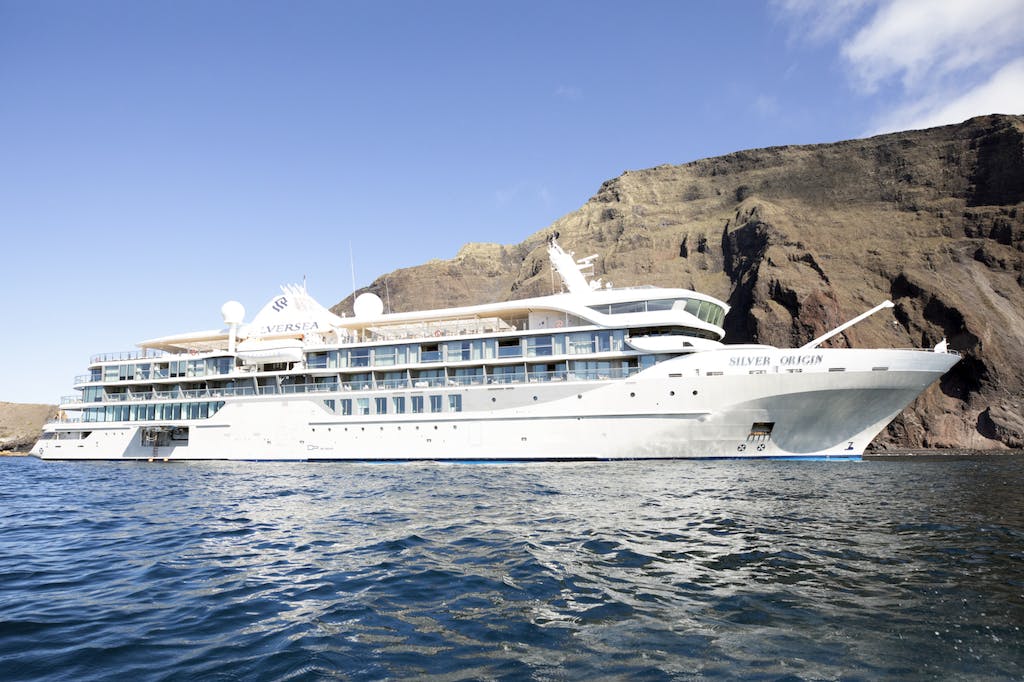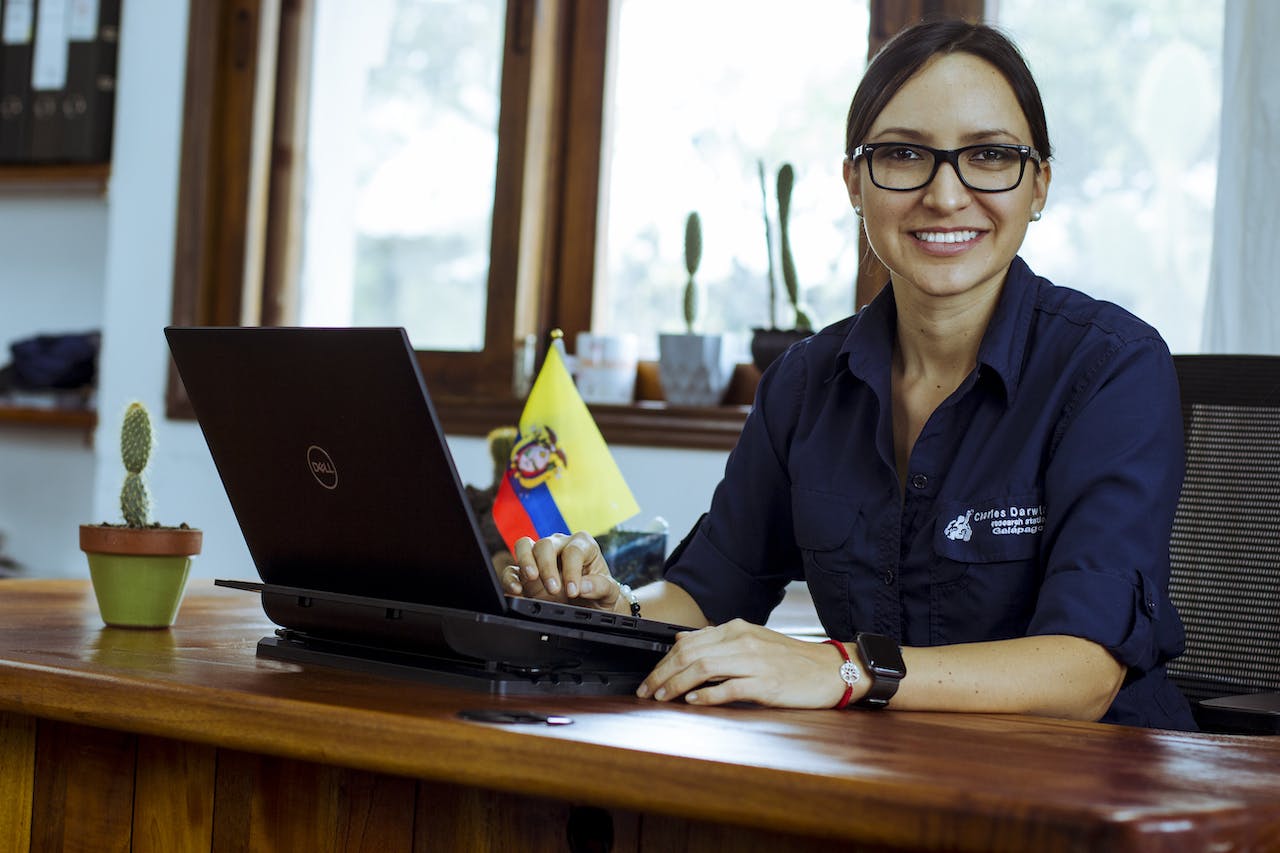Homegrown Steward of Sustainability: Meet Johanna Carrión, Silver Origin’s Godmother
Johanna Carrión is quite familiar with the title of godmother. Though only 32 years old, the Galápagos native already has four godchildren to her name. Her fifth, however, just happens to be a 5,800-ton, steel-frame toddler ‘born’ in 2020. Silver Origin, Silversea’s first-ever destination-specific ship, officially became Carrión’s honorary godchild during the ship’s christening ceremony in San Cristóbal, Galápagos, on February 25, 2022. She is also involved with the Charles Darwin Foundation.
But it’s not Carrión’s familiarity in the field of godmothering that landed her the honorary title, although it does have to do with her experience nurturing children. Since 2020, the young galapagueña has served as the executive director and CEO of Fundación Scalesia, an educational foundation that aims to provide quality education to students and local communities on Santa Cruz with the goal of fostering long-term conservation.
At the core of Scalesia is the Tomás de Berlanga school, which offers the roughly 220 students bilingual education while focusing on a curriculum that emphasizes sustainability principles. Graduates of the Berlanga school are now government advisors, researchers at the Charles Darwin Research Station (CDRS), employees of the National Park, and sustainability-focused professionals. The school is near and dear to Carrión’s heart, as she was one of the students who graduated from its first class back in 2007. Moreover, her brother is currently a student at the institution and is scheduled to graduate this year.
In addition to her role at Scalesia, Carrión has also served since 2013 as the Executive Coordinator of the Charles Darwin Foundation in the Galápagos, leading the inter-institutional coordination, supporting the establishment and strengthening of national and international alliances. And in 2019, she was recognized as a National Geographic Society Explorer.
In Silver Origin — whose primary purpose is to allow guests to travel deeper in the Galápagos while ensuring the smallest possible impact on the archipelago’s delicate environment — Carrión connects with a kindred spirit; one as determined and devoted as her to protect the islands for generations to come. Galápagos tourism is a real thing and spreading the word to visitors is important. We recently caught up with the Scalesia executive to learn more about her life, her work and her mission in Galápagos.

What’s it like to grow up in Galápagos?
It’s a paradise. Of course, it has its challenges, but it’s definitely beautiful. Getting to interact with nature all the time is priceless, from sea turtles on the coast to tortoises in the highlands. We have an incredible school of nature here that’s teaching us all the time, so it was a privilege to be raised here in Santa Cruz. I actually lived on another island for a few years, Isabela, which is bigger but has a smaller population. On Isabela, I was lucky to learn how to read, write, ride a bicycle and swim — all the basic skills. Then my family moved back to Santa Cruz, so I could go back to the Berlanga school.
Were you exposed at an early age to the importance of conservation and sustainability?
I’m the daughter of a former park ranger who now works for a conservation NGO, so my dad was my first connection to nature. And my mother is a teacher, so she was also guiding me all the time towards loving the place that I live in and caring about it. And then once I was around 4 or 5 years old, I started studying at the Berlanga school. So, of course, that was another important influence.
As an alumnus of Tomás de Berlanga school, how does it feel to now lead it?
It’s very rewarding, particularly because of the recent challenges we’ve faced. On April 16, 2020, the Berlanga school had announced that it was shutting down due to the economic impact that the COVID-19 pandemic had on the families and on the school itself. So the community members — alumni, teachers, general assembly members and so on — came together with a proposal to allow the school to continue its operations. We were lucky to come up with a really strong plan to convince the General Assembly of the Scalesia Foundation to keep the school going, and I was appointed as the CEO. But that was a really interesting movement that brought us all together for this important cause.
I know that when I was a student at the Berlanga school, there were people doing the same efforts we are doing now, so it’s an opportunity to pay back those efforts and an honor to lead the Scalesia Foundation today. It’s an incredible feeling to know you’re doing something right when you have a group of students graduating like we had last year, and we’re having another group this year. It really fuels your drive to keep on working.

You work for both Scalesia and the Charles Darwin Foundation. How do you manage both roles? Do they overlap?
At certain points they do. I’ve worked for the Darwin Foundation since 2013, and it’s been really interesting to be here and to learn from all the challenges and different efforts towards conservation and sustainable development of the archipelago, as well as the interactions between the institutions. In the last four years, the Charles Darwin Foundation has been strengthening its efforts on environmental education, too. So both roles sometimes do complement each other, but it’s definitely a challenge because I finish my work at the CDF and then continue on with Scalesia, sometimes over the weekend! But I’m very happy to work with both foundations and I hope I’ve been successful in both.
You’ve said that education is the missing gap between the communities and the conservation of Galápagos. What are the main challenges you face in your mission to bridge that gap?
Several, but I think that one of the main challenges is definitely associated with human resources. We don’t have that many local residents studying to become teachers, for example. It’s not considered a desirable job as it can be very challenging. I don’t know if I would have the skills to become a teacher; that’s why I admire and respect my mother so much for doing it!
On the other hand, the special advantage that teachers have here is that the Galápagos archipelago is a living lab. It’s like a microcosm of everything that happens in the world. When you think of population growth, waste management, invasive species, climate change … these are all challenges we also face here. So this provides teachers an opportunity to be able to link subjects with the specific examples happening in Galápagos.
What do you consider is the long-term goal for the Scalesia Foundation and the Galápagos?
To foster long-term conservation in the Galápagos through education. We should provide students with the opportunity to develop a deeper understanding and appreciation for the special place they live in; it is essential that they are able to acquire the skills and desires to participate in the archipelago’s long-term protection. It’s crucial to help students attain the skills they need to be able to be competitive, once they go to universities or decide to apply for a job and so on.
Also, in terms of long-term goals for the Scalesia Foundation, since 2021 the islands have an innovative curriculum that is called ‘Education for Sustainability,’ which is contextualized to Galápagos. This opens opportunities for all the teachers and children in Galápagos to connect learning processes with the local reality and get to understand their place and care for it. Sometimes visitors know more about the island’s ecosystems and challenges than the permanent residents here. Having a curriculum that is as specific for the Galápagos but includes the global perspective is crucial for the long term.
What are your thoughts on your new godchild, Silver Origin?

I think the ship is highly adapted to how the operations in the Galápagos should be from a sustainable perspective and low-impact operations. I am really pleased with the ship’s features and how it is specifically designed to operate here considering the fragile ecosystem of the Galápagos. This gives you a better idea of the commitment from Silversea to the conservation and sustainability of the islands. And I’m very honored to have been chosen as the ship’s godmother and incredibly proud of my ‘heavy’ godchild.
What is your favorite Galápagos species?
The marine iguana. When they’re on the land near a rock relaxing and thermoregulating, it’s amazing how well they blend in to their surroundings. You can hardly tell where they are! But when they’re swimming, they’re just incredible. They’re so fast and swim so elegantly. They might not be the most eye-pleasing species, but I find them fascinating. In terms of bird species, I have to say the Galápagos petrel. These amazing birds feed in the sea and nest in the highlands. And every year during nesting season they come back to the very same nest.
What do you consider is one of the top reasons to visit the Galápagos?
Galápagos is one of the very few places where animals are not afraid of you and that is always something that surprises visitors. The iguanas or sea lions don’t really care if you’re passing by, and that’s fascinating. But of course, you still have to maintain a safe distance. And although there’s still a lot that needs to be done in terms of education, the local communities do understand the importance of these animals for the ecosystem. And it’s heartwarming for visitors to see how much the locals care for these species. For me, it’s always a treat to see kids telling visitors: ‘Stay two meters away from the sea lion!’
An expedition-inspired christening
On February 25, 2022, Silversea Cruises officially christened its first destination-specific vessel, Silver Origin, in the Galápagos Islands. The ceremony was an expedition-inspired affair in San Cristóbal, where guests took to the water on Silver Origin‘s Zodiacs, raising a glass of champagne as Silversea officially welcomed the ship to its fleet of 10. Carrión, officially unveiled as the ship’s Godmother during the ceremony, made her first address to Silver Origin’s guests, before Bishop Patricio Bonilla blessed the vessel.
Interested in learning about more of Silversea’s sustainability initiatives? Read about them here.
